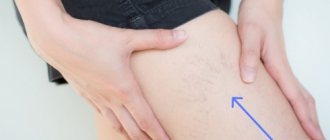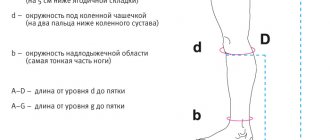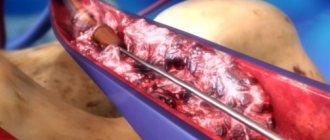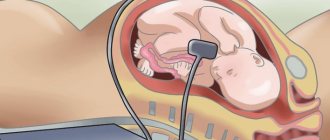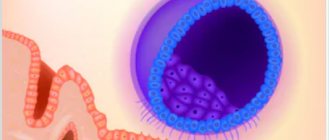Varicose veins are a chronic disease of the superficial veins of the lower extremities. During pregnancy, this disease progresses due to changes in the woman’s body. Treatment of pregnant women is carried out under the supervision of the attending physician and phlebologist. Read more about varicose veins and laser treatment of varicose veins in our clinic.
Page navigation:
- Causes of varicose veins in pregnant women
- How does varicose veins develop?
- Signs of varicose veins
- Varicose veins of the vulva and vagina
- Varicose veins of the pelvic organs: uterus, bladder, rectum and anus
- What are the dangers of varicose veins during pregnancy?
- Prevention of varicose veins and its complications during pregnancy
- Diagnostics
- Treatment methods
Symptoms of varicose veins of the labia
More often, symptoms of varicose veins of the female genital organs appear during pregnancy at 18-24 weeks. In multiparous women, signs of the disease may become apparent as early as 12-14 weeks. A natural clinical manifestation of the pathology is deformation of the vascular walls. The veins dilate, look flabby, with nodular formations, and the labia enlarges. Along with external symptoms, there are also painful sensations:
- burning in the perineum;
- nagging pain radiating to the leg during physical activity;
- feeling of heaviness, swelling in the intimate area;
- dysmenorrhea (heavy bleeding accompanied by pain, changes in the menstrual cycle);
- dyspareunia (pain during intimate contact);
- discoloration and dry skin.
Symptoms increase gradually. As the disease progresses, painful urination and chronic pelvic pain may occur. In pregnant women, varicose veins cause miscarriage or premature birth.
Forms and causes of vulvitis
Inflammation occurs both in adulthood and in girls under 10 years of age against the background of frequent acute respiratory viral infections, reduced immunity, pinworm infection and antibiotic use. At risk are pregnant girls, women with menopausal syndrome, whose mucous membranes become thinner due to decreased estrogen production. Symptoms of vulvitis appear from infection with pathogenic microorganisms (Trichomonas, chlamydia) or from an increase in one’s own opportunistic flora (fungi, herpes viruses, E. coli).
There are vulvitis:
- primary – an independent disease;
- secondary – a consequence of other diseases.
The main causes of primary vulvitis:
- genital injuries;
- intestinal dysbiosis;
- tight, synthetic underwear;
- using sanitary pads without changing for a long time;
- insufficient personal hygiene.
Secondary vulvitis occurs against the background of:
- infections, inflammations of the genitourinary system – colpitis, vaginitis, cervicitis and others;
- changes in the vaginal microflora due to long-term self-medication with antibiotics;
- disruptions in the functioning of the endocrine system (diabetes mellitus, adrenal gland diseases);
- infection with worms and other parasites (symptoms worsen at night when roundworms or pinworms emerge from the anus);
- vitamin deficiency;
- immunodeficiency.
Depending on the main provoking factor, several forms of the disease are distinguished:
- Bacterial vulvitis. The cause of inflammation is opportunistic microorganisms or infections. There is a distinction between nonspecific vulvitis, caused by an imbalance of microflora, and a specific form, which develops when infected with an infection from a sexual partner. Among the most aggressive pathogens are gonococci, chlamydia, trichomonas;
- Allergic vulvitis. Inflammation is caused by contact with an allergen, for example, when particles of washing powder are not completely rinsed out of the laundry, or a gel with fragrances is used for intimate hygiene;
- Candidiasis (fungal) vulvitis. The causative agent of the disease is fungi of the genus Candida. Candidiasis vulvitis more often than others becomes chronic. An exacerbation can be triggered by any factors: from stress to a cold. Candidiasis (fungal vulvitis) is also classified as nonspecific inflammation;
- Atrophic vulvitis. The disease develops during natural changes in the tissues of the internal genital organs during menopause. Atrophic processes can begin after removal of the ovaries.
Vulvitis occurs acutely and chronically. In the acute form, the symptoms of the disease appear suddenly and quickly intensify, increasing over 2-3 days. During this period, it is important to consult a doctor, undergo a diagnosis of vulvitis and receive quality treatment. The risk of relapse will be minimal.
If acute vulvitis is treated incorrectly or if the doctor’s recommendations are not followed, the inflammation will become chronic. Symptoms will subside and reappear, reducing quality of life. Even a young girl can become a regular gynecology patient if she ignores the signs of the disease.
There is also subacute vulvitis - a transitional form of inflammation.
Why does it appear
The main prerequisite for the development of varicose veins of the labia is the insufficient strength of the connective tissue that forms the vascular walls. Under the influence of a number of factors, the number of collagen fibers decreases and muscle tone decreases. An increase in blood pressure and the filling of blood vessels leads to their stretching and expansion to such an extent that the lumen is no longer blocked by the valve. Blood overflows into the subcutaneous veins of the genital organs, contributing to the development of the disease.
Triggering factors for varicose veins of the genital organs in women:
- Hormonal changes. During pregnancy, the production of progesterone and relaxin increases, which relax the smooth muscles of the venous walls. Due to the abundant blood flow, the valves do not completely block the lumen of the vessel, resulting in venous stagnation.
- Fetal growth during pregnancy. Increasing in size, the uterus puts pressure on the vessels, which affects the volume of venous blood and the elasticity of the venous walls.
- Increased blood flow. During pregnancy, the amount of fluid circulating in the vascular bed constantly increases, which causes increased blood pressure and dilation of the veins.
- Sedentary lifestyle. Prolonged sitting or standing leads to stagnation, which provokes vasodilation.
- Excess weight. Excess body weight creates a load on the entire body, the cardiovascular system, which causes deformation of the vascular walls.
- Genetic predisposition. If someone in your family has suffered from varicose veins, the likelihood of developing pathology increases.
- Chronic constipation. Digestive disorders lead to stagnant processes in the pelvic organs and, as a result, varicose veins.
Pathological expansion of the vascular walls may persist in women after childbirth. Normal blood flow in tissues is also hampered by inflammatory processes, tumors of the genital organs, and the use of hormonal contraceptives.
Prevention of varicose veins of the small pelvis
Despite the fact that treatment of an altered vein using embolotherapy is accessible and effective, it is better to prevent any disease. In order for each vein to remain in its natural state, it is necessary to ensure normal blood circulation in the body. To do this, you should follow the simplest rules:
- To live an active lifestyle. Even if you have to spend the whole day in the office at the computer, you can always take a leisurely walk in the evening. Exercises for the abdominal area, dance movements of “waggling” and “swaying” with the pelvis, which accelerate blood flow in this part of the body, would be appropriate. Of course, it should be remembered that excessive exercise can provoke the disease, rather than prevent it.
- Be able to relax emotionally. Constant stress often becomes the main cause of problems with blood circulation and stagnant processes. It is very useful to take baths with various aromatic oils, experience positive emotions, sing, and dance.
- It is advisable to have a regular intimate life. Of course, if you have already discovered signs of the disease, you should consult a specialist.
By properly combining work and rest, it is easy to prevent the occurrence of many unpleasant diseases, as well as significantly improve your health.
Request a call back Get a free consultation
Vaginal varicose veins in pregnant women
This type of pathology is characterized by dilation of blood vessels located in the vagina. The disease often develops against the background of existing varicose veins. The vascular walls lose elasticity, become fragile and vulnerable. In pathological veins, blood circulation is impaired and the risk of blood clots increases.
Vaginal varicose veins are accompanied by pain in the perineum, flatulence, indigestion, constipation, and frequent urination. A prolonged illness is characterized by cramps and a feeling of heaviness in the legs.
During pregnancy, if the presence of varicose veins of the labia at a late stage is confirmed, a cesarean section is performed, since natural childbirth can be dangerous to the health of the mother and child.
Features of therapy at the center of Professor Kapranov
Professor S. A. Kapranov offers modern and effective treatment for vascular pathology. His students and colleagues have accumulated (over more than 10 years) experience in carrying out such minimally invasive interventions, unique for Russian medicine, having operated on several hundred patients. Possessing unique knowledge and skills, they will quickly and effectively help in the treatment of varicose veins.
When treating gynecological diseases (including varicose veins of the small pelvis), the endovascular surgery center uses the latest equipment and innovative instruments. This allows you to treat pelvic varicose veins as carefully and accurately as possible.
An important factor is the optimal cost of treatment for a disease such as pelvic varicose veins.
Sergei Anatolyevich was awarded a high award (Russian Federation Government Prize) for restoring the reproductive health of the fair half of humanity.
The Center for Endovascular Surgery offers an innovative approach to treatment - embolization of pathological veins of the small circle with detachable coils. You can choose the clinic for the intervention yourself. Experienced specialists will do everything so that you can avoid discomfort and numerous risks. You will get rid of varicose veins in the shortest possible time and can return to your normal lifestyle.
Varicose veins of the vulva
Vulva is a term used to describe the female genitourinary organs at the entrance to the birth canal. With the development of this type of pathology, patients complain about unpleasant sensations in the lower abdomen; spider veins and nodes are noticeable on the skin of the labia. If left untreated during pregnancy, the risk of rupture of the uterine vessels, death of the child and heavy loss of blood in the mother increases.
Complications
If swelling on the penis does not cause inconvenience and does not cause pain, it may be just a temporary deformation of the muscles and tendons of the penis, characteristic of male physiology, and not varicose veins.
But in any case, you need to see a urologist, since an advanced state of penile varicose veins can result in rupture of the veins during the next erection and internal or external hemorrhage. Such an ending, in the worst case, will lead to the complete loss of the functionality of the penis and complete impotence, and in the “best” - to infertility.
Diagnostics
Standard diagnosis involves examination on a gynecological chair to identify dilated, nodular vessels, cyanosis and smoothness of the vaults of the vaginal wall. Selective variography helps determine in which zone the blood is discharged into the veins.
To assess the vascular system of the pelvic area, instrumental studies are prescribed:
- ultrasonography;
- Doppler ultrasound;
- laparoscopy;
- CT scan of the pelvic organs.
In the classical course of the pathology, diagnosing the disease is not difficult. Based on the results, the gynecologist prescribes treatment.
Treatment of varicose veins of the labia
Treatment tactics are determined by the severity of the pathology, the risk of complications and differ in the postpartum period and during pregnancy. For uncomplicated vulvar varicose veins, medications are prescribed:
- venotonics (increase the contractility of vascular smooth muscles, strengthen valves);
- antiplatelet agents (reduce the risk of thrombosis);
- angioprotectors (prevent damage to the walls of blood vessels).
Women are prescribed to wear compression garments, which reduce pressure and stress on the venous valves, normalizing blood circulation. It is recommended to limit physical activity and introduce more vegetables and fruits into the diet to avoid constipation.
If conservative therapy does not lead to positive results, surgical treatment is resorted to. But this is possible only after delivery. Minimally invasive surgical methods for treating varicose veins of the genital organs include:
- Sclerotherapy. A surgical operation in which a drug is injected into the lumen of a vein using a very thin needle, causing it to close due to the proliferation of connective tissue. After the operation, varicose nodes disappear.
- Laser coagulation. Micro-instruments are inserted through a skin puncture. Under the influence of the beam, the walls of the vessel are sealed, after which it dissolves.
- Miniphlebectomy. Surgical intervention to remove varicose veins through a skin puncture.
Drug treatment helps reduce the severity of symptoms. Modern surgical techniques are assessed as minimally invasive and safe. If you seek medical help in a timely manner, it is possible to achieve the disappearance of signs of pathology.
Benefits of foam sclerotherapy
- Simplicity - treatment takes place on an outpatient basis.
- Availability.
- Good cosmetic effect.
- Speed of implementation - the procedure lasts approximately an hour.
- The ability to combine with your usual lifestyle and busy work schedule.
- The effect is noticeable immediately after treatment - the affected vein disappears.
- No contraindications (except for one – allergy to the drug).
- Getting rid of the disease in a short time.
- The treatment takes place without incisions, anesthesia and pain.
- Almost complete absence of relapses.
Join the number of patients who have already gotten rid of varicose veins using foam sclerotherapy! Sign up for a consultation with a surgeon or phlebologist and take the first step towards recovery.
